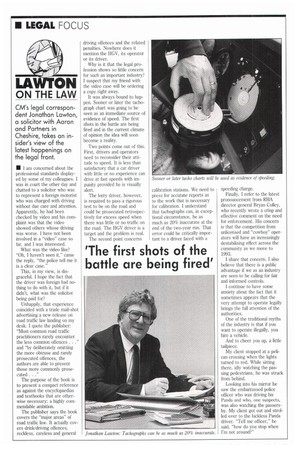'The first shots of the battle are being fired'
Page 22

If you've noticed an error in this article please click here to report it so we can fix it.
CM's legal correspondent Jonathan Lawton, a solicitor with Aaron and Partners in Cheshire, takes an insider's view of the latest happenings on the legal front.
• I am concerned about the professional standards displayed by some of my colleagues. I was in court the other day and chatted to a solicitor who was to represent a foreign motorist who was charged with driving without due care and attention. Apparently, he had been checked by video and his complaint was that the video showed others whose driving was worse. I have not been involved in a "video" case so far, and I was interested.
What was the video like? "Oh, I haven't seen it," came the reply, "the police tell me it is a clear case."
This, in my view, is disgraceful. I hope the fact that the driver was foreign had nothing to do with it, but if it didn't, what was the solicitor being paid for?
Unhappily, that experience coincided with a trade mail-shot advertising a new release on road traffic law landing on my desk. I quote the publisher: "Most common road traffic practitioners rarely encounter the less common offences . . . and "by deliberately omitting the more obtruse and rarely prosecuted offences, the authors are able to present those more commonly prosecuted. . ."
The purpose of the book is to present a compact reference as against the encyclopaedias and textbooks that are otherwise necessary: a highly commendable ambition.
The publisher says the book covers the "major areas" of road traffic law. It actually covers drink/driving offences, reckless, careless and general driving offences and the related penalties. Nowhere does it mention the HGV, its operator or its driver.
Why is it that the legal profession shows so little concern for such an important industry? I suspect that my friend with the video case will be ordering a copy right away.
It was always bound to happen. Sooner or later the tachograph chart was going to be seen as an immediate source of evidence of speed. The first shots in the battle are being fired and in the current climate of opinion the idea will soon become a reality.
Two points come out of this. First, drivers and operators need to reconsider their attitude to speed. It is less than satisfactory that a car driver with little or no experience can drive at fast speeds with impunity provided he is visually alert.
The lorry driver, however, is required to pass a rigorous test to be on the road and could be prosecuted retrospectively for excess speed when there was little or no traffic on the road. The HGV driver is a target and the problem is real.
The second point concerns calibration stations. We need to press for accurate reports as to the work that is necessary for calibration. I understand that tachographs can, in exceptional circumstance, be as much as 20% inaccurate at the end of the two-year run. That error could be critically important to a driver faced with a speeding charge.
Finally, I refer to the latest pronouncement from RHA director general Bryan Colley, who recently wrote a crisp and effective comment on the need for enforcement. His concern is that the competition from unlicensed and "cowboy" operators will have an increasingly destabilising effect across the community as we move to 1993.
I share that concern. I also believe that there is a public advantage if we as an industry are seen to be calling for fair and informed controls.
I continue to have some anxiety about the fact that it sometimes appears that the very attempt to operate legally brings the full attention of the authorities.
One of the traditional myths of the industry is that if you want to operate illegally, you hire a vehicle.
And to cheer you up, a little tailpiece.
My client stopped at a pelican crossing when the lights turned to red. While sitting there, idly watching the passing pedestrians, he was struck from behind.
Looking into his mirror he saw the embarrassed police officer who was driving his Panda and who, one suspects, was also watching the passersby. My client got out and strolled over to the luckless Panda driver. "Tell me officer," he said, "how do you stop when I'm not around?"
































































































